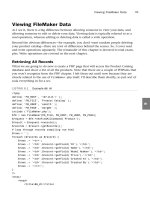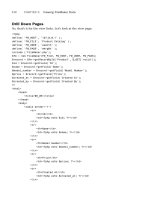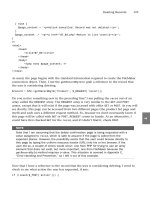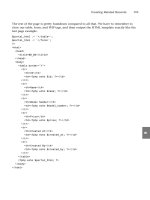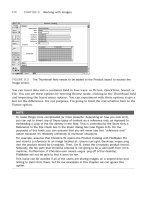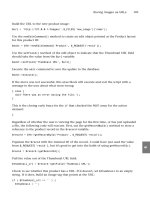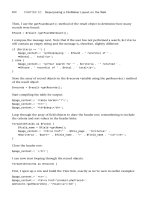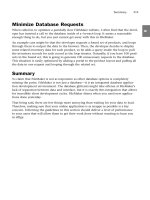Web Publishing with PHP and FileMaker 9- P8 docx
Bạn đang xem bản rút gọn của tài liệu. Xem và tải ngay bản đầy đủ của tài liệu tại đây (87.4 KB, 15 trang )
Viewing FileMaker Data
As I see it, there is a big difference between allowing someone to view your data, and
allowing someone to edit or delete your data. Viewing data is typically referred to as a
read operation, whereas editing or deleting data is called a write operation.
Beyond the obvious differences—for example, you don’t want random people deleting
your product catalog—there are a lot of differences behind the scenes. So, I cover read
and write operations separately. The remainder of this chapter is devoted to read exam-
ples. Write operations are covered in the next chapter.
Retrieving All Records
What we are going to do now is create a PHP page that will access the Product Catalog
database and show a list of all the products. Note that there are a couple of PHPisms that
you won’t recognize from the PHP chapter. I left them out until now because they are
closely related to the use of
FileMaker.php itself. I’ll describe them shortly, so just sort of
soak everything in for a sec.
LISTING 6.1 Example 06 01
<?php
define( ‘FM_HOST’, ‘127.0.0.1’ );
define( ‘FM_FILE’, ‘Product Catalog’ );
define( ‘FM_USER’, ‘esmith’ );
define( ‘FM_PASS’, ‘m4rg0t’ );
include (‘FileMaker.php’);
$fm = new FileMaker(FM_FILE, FM_HOST, FM_USER, FM_PASS);
$request = $fm->newFindAllCommand(‘Product’);
$result = $request->execute();
$records = $result->getRecords();
# loop through records compiling row html
$rows = ‘’;
foreach ($records as $record) {
$rows .= ‘<tr>’;
$rows .= ‘<td>’.$record->getField(‘ID’).’</td>’;
$rows .= ‘<td>’.$record->getField(‘Name’).’</td>’;
$rows .= ‘<td>’.$record->getField(‘Model Number’).’</td>’;
$rows .= ‘<td>’.$record->getField(‘Price’).’</td>’;
$rows .= ‘<td>’.$record->getField(‘Created At’).’</td>’;
$rows .= ‘<td>’.$record->getField(‘Created By’).’</td>’;
$rows .= ‘</tr>’;
}
?>
<html>
<head>
<title>06_01</title>
Viewing FileMaker Data
95
6
</head>
<body>
<table border=”1”>
<tr>
<th>ID</th>
<th>Name</th>
<th>Model Number</th>
<th>Price</th>
<th>Created At</th>
<th>Created By</th>
</tr>
<?php echo $rows; ?>
</table>
</body>
</html>
Right off the bat, you probably noticed the four “define” lines as something new:
define( ‘FM_HOST’, ‘127.0.0.1’ );
define( ‘FM_FILE’, ‘Product Catalog’ );
define( ‘FM_USER’, ‘esmith’ );
define( ‘FM_PASS’, ‘m4rg0t’ );
Define is a PHP construct that is similar to a variable in that you are specifying a
name/value substitution, but in this case you are defining a constant. In other words,
after this line:
define( ‘FM_HOST’, ‘127.0.0.1’ );
…the PHP parser will replace any instance of FM_HOST with the value 127.0.0.1 for the
duration of the script.
However, define differs from variables in a couple of ways. First, when you use the
defined constant, you don’t put a dollar sign in front of it. This means that you can’t use
any reserved PHP constants as your constants. By the way, it’s considered good form to
define your constants as uppercase, although it’s not required. However, they are case
sensitive after you define them, so
FM_HOST is not the same thing as FM_Host.
Second, defined constants are purposely very rigid. After a constant is defined to have a
value, you cannot redefine it during the course of the script. This might seem strange—I’m
basically saying that it’s a variable that can’t vary. It’s a constant. The nice part about it is
that if you try to redefine it anywhere, you get an error. This protects you from acciden-
tally overwriting a value if you inadvertently reuse a constant name, so for vital informa-
tion, defined constants are very handy.
96
LISTING 6.1 Continued
Still, you are probably asking yourself, “Why would I define FM_HOST as a constant that
equals
127.0.0.1, when I could just use 127.0.0.1?”
Great question. The answer is twofold:
. If you used 127.0.0.1 in hundreds of places within a script (or in many scripts), you
would have to carefully replace it in each location it was used if you moved your
host to another IP address. Using the define statement allows you to change it in
just one place.
. Hard-coding sensitive information in a PHP page that is accessible on the Internet is
bad from a security standpoint. If you look at the third and fourth defined
constants, you will see that I am embedding database login information in the
current page. This is considered a security risk, but I don’t want to confuse the topic
at hand. I’ll cover this in more detail in Appendix B, “Security Concerns.”
Moving on….
include (‘FileMaker.php’);
The include statement is supercool. It allows you to, well, “include” the contents of
another file into the current file. So, whatever’s inside the
FileMaker.php page might as
well have been cut and pasted into this page.
This is great when you have things like config pages, or global pages that need to get
reused in lots of other pages. It lets you write something once and then use it all over
the place.
In this case, the engineers at FileMaker, Inc. have written a page called
FileMaker.php and
we want to include their work in our page without having to cut and paste all their code
from their file into our file (and, yes, it’s a lot of code). As time goes by and FMI releases
updates to
FileMaker.php, we won’t have to worry about our pages—they will automati-
cally have the updated code included. Pretty sweet, no?
The next line is
$fm = new FileMaker(FM_FILE, FM_HOST, FM_USER, FM_PASS);
This line represents a big juicy can of worms known as object-oriented programming
(OOP). I’d love nothing more than to get into a long discussion about the relative merits
of OOP, but that would be totally beside the point. Put another way, you don’t need to
understand OOP to use
FileMaker.php, any more than you need to understand the inter-
nal combustion engine to drive to soccer practice.
However, there are two OOP terms that I will be using quite a bit: object and method. I will
clarify these terms by example throughout the remainder of this chapter.
Here’s that line again:
$fm = new FileMaker(FM_FILE, FM_HOST, FM_USER, FM_PASS);
Viewing FileMaker Data
97
6
This line creates a FileMaker connection object for a particular user (esmith) with pass-
word (m4rg0t) to a particular FileMaker file (Product Catalog) on a particular FileMaker
Server machine (127.0.0.1).
In this case, that connection object is then stored in the
$fm variable.
Here are a few examples of other possible “FileMaker connection” strings:
$fm = new FileMaker(‘Product Catalog’, ‘127.0.0.1’, ‘esmith’, ‘m4rg0t’);
$connection = new FileMaker($ClassFile, ‘localhost’, ‘barbO’, ‘s34f2kAFed32!dk’);
$dbh = new FileMaker(‘TimeTracker.fp7’, ‘jonathanstark.com’, $username, $password);
As you can see, you are free to choose any variable in which to store the connection
object. Also, you can specify your parameters any way you want, as long as you keep
them in the correct order. After you have the connection object stored in the
$fm variable,
we can ask it to do stuff for us. Let’s look at the next line:
$request = $fm->newFindAllCommand(‘Product’);
Objects contain methods. A method inside of an object is sort of like a script inside of a
FileMaker Pro file—you call it, maybe with some parameters. Then, it does what you
asked, and maybe returns a result to you. If a method returns a result, it could be text, a
number, or even another object. You can then store the result of the method in a variable.
newFindAllCommand() is a method of the FileMaker connection object. Here, we are telling
our
$fm connection to create a new FindAllCommand on the Product layout. This is sort of
like going into find mode on the product layout in FileMaker Pro.
Remember, I just said that methods can return things, and sometimes that returned thing
is yet another object. As it happens, the
newFindAllCommand() method returns a Find All
object that I am storing here in the
$request variable.
I can now call the execute() method of the Find All object stored in the $request
variable:
$result = $request->execute();
As you can probably guess, this is where I am executing the request I created on the pre-
vious line. The result of the request is yet another object, which is then stored in the
$result variable.
If you are not familiar with OOP, your head is probably swimming right now. Try not to
worry about it too much. In my experience, the explanation of OOP is more confusing
that just looking at a few examples. If you are struggling, just keep playing with the
examples until you feel like you are starting to feel comfortable. Then, read the explana-
tion again. Rinse, repeat
CHAPTER 6 Viewing FileMaker Data
98
NOTE
When I first started using the
newFindAllCommand() method, I was a little peeved
that it was a two-step process: I had to create it on one line, and then execute it on
another. I wondered why it didn’t just execute right away and give me all my records.
As I became more familiar with
FileMaker.php, the reason became clear. I might want
to do more than merely find all the records. For example, I might want to request that
the records be returned sorted by one or more of the fields in the resultset. Placing
the execute command on a separate line allows for this “sort” of thing (pun intended).
You might think that the result of executing the
FindAllCommand on the Product layout
would contain all of the records from the Product table, and you’d be right! But only
about half right. The result object actually contains much more, like the found set count,
the total number of records in the table, a list of fields that are on the layout, and so on.
For now, we are just concerned with the records.
To pull just the records out of the result object, you use the
getRecords() method:
$records = $result->getRecords();
After this line executes, the $records variable will contain an array of record objects (yep,
arrays can contain objects). We can loop through the array of record objects with our
trusty
foreach loop to create rows for an HTML table:
$rows = ‘’;
foreach ($records as $record) {
$rows .= ‘<tr>’;
$rows .= ‘<td>’.$record->getField(‘ID’).’</td>’;
$rows .= ‘<td>’.$record->getField(‘Name’).’</td>’;
$rows .= ‘<td>’.$record->getField(‘Model Number’).’</td>’;
$rows .= ‘<td>’.$record->getField(‘Price’).’</td>’;
$rows .= ‘<td>’.$record->getField(‘Created At’).’</td>’;
$rows .= ‘<td>’.$record->getField(‘Created By’).’</td>’;
$rows .= ‘</tr>’;
}
Just like all of the other objects we have seen so far, the record objects have methods.
Here, I am using the
getField() method of each record object to pull the field values out.
The parameter of the
getField() method is the name of the field as defined in FileMaker
for the Product table.
The other thing I should explain about this chunk of code is the
.= concatenation opera-
tor. This is a commonly used shorthand that tells the PHP parser to append data to a
variable, rather than overwriting the previous contents of the variable.
Viewing FileMaker Data
99
6
So, this:
$rows .= ‘<tr>’;
is shorthand for this:
$rows = $rows . ‘<tr>’;
After the foreach loop is closed, I close the php block and output the bulk of the page as
literal HTML. Nothing special here until you get down to this line:
<?php echo $rows; ?>
All I’m doing is using a little bit of PHP to echo out the HTML for the table rows that I
compiled in the PHP section previously. This will be a common paradigm throughout the
rest of the book: First, dynamic data is gathered from the database and converted to
HTML, and then the dynamically created HMTL is inserted into key spots of a mostly
static HTML document. I refer to this as a template method.
I used an alternative method in the PHP chapter where everything was echoed out by
PHP. That was fine at the time because the HTML was pretty simple. However, as the
HTML gets more complicated, it becomes quite a chore to escape all your single and
double quotes. For this and other reasons, I find that using an HTML template method is
much better for real-world applications.
Sorting Records
Now I am going to slightly modify the previous example to show you how to allow the
user to sort the product records by clicking a column header.
LISTING 6.2 Example 06 02
<?php
define( ‘FM_HOST’, ‘127.0.0.1’ );
define( ‘FM_FILE’, ‘Product Catalog’ );
define( ‘FM_USER’, ‘esmith’ );
define( ‘FM_PASS’, ‘m4rg0t’ );
include (‘FileMaker.php’);
$fm = new FileMaker(FM_FILE, FM_HOST, FM_USER, FM_PASS);
$request = $fm->newFindAllCommand(‘Product’);
if(isset($_GET[‘sortby’]) and $_GET[‘sortby’] != ‘’) {
$request->addSortRule($_GET[‘sortby’], 1);
}
$result = $request->execute();
$records = $result->getRecords();
$rows = ‘’;
foreach ($records as $record) {
$rows .= ‘<tr>’;
CHAPTER 6 Viewing FileMaker Data
100
$rows .= ‘<td>’.$record->getField(‘ID’).’</td>’;
$rows .= ‘<td>’.$record->getField(‘Name’).’</td>’;
$rows .= ‘<td>’.$record->getField(‘Model Number’).’</td>’;
$rows .= ‘<td>’.$record->getField(‘Price’).’</td>’;
$rows .= ‘<td>’.$record->getField(‘Created At’).’</td>’;
$rows .= ‘<td>’.$record->getField(‘Created By’).’</td>’;
$rows .= ‘</tr>’;
}
?>
<html>
<head>
<title>06_02</title>
</head>
<body>
<table border=”1”>
<tr>
<th><a href=”06_02.php?sortby=ID”>ID</a></th>
<th><a href=”06_02.php?sortby=Name”>Name</a></th>
<th><a href=”06_02.php?sortby=Model+Number”>Model Number</a></th>
<th><a href=”06_02.php?sortby=Price”>Price</a></th>
<th><a href=”06_02.php?sortby=Created+At”>Created At</a></th>
<th><a href=”06_02.php?sortby=Created+By”>Created By</a></th>
</tr>
<?php echo $rows; ?>
</table>
</body>
</html>
Listing 6.2 is exactly like 6.1 with the following exceptions:
. I have converted the table header cells into sort links.
. I modified the PHP to check for and handle sorting.
Let’s look at the PHP first:
if(isset($_GET[‘sortby’]) and $_GET[‘sortby’] != ‘’) {
$request->addSortRule($_GET[‘sortby’], 1);
}
New PHP alert! This is the first time you have seen the isset() language construct and
the
and operator. Let’s cover the and operator first.
Inside of an
if expression, the and operator is used to separate two conditions that both
must be true for the
if expression as a whole to be true. As you might guess, there’s an or
Viewing FileMaker Data
101
6
LISTING 6.2 Continued
operator that you can use to separate conditions where only one or the other (or both)
need to be true for the
if to evaluate to TRUE.
The isset() language construct just checks to make sure that a variable or array element
exists. It can be empty, but as long as it exists,
isset() returns TRUE.
I am using isset() here because I would have gotten a PHP warning if $_GET[‘sortby’]
didn’t exist and I had done this:
if($_GET[‘sortby’] != ‘’) {
So, I am checking to see whether the $_GET superglobal array contains any information
for
‘sortby’. The first time the page loads, there isn’t any data there, so the code inside
of the
if block is skipped (hence the isset() check). However, after the page has loaded,
the user could click one of the links in the column headers:
<th><a href=”06_02.php?sortby=ID”>ID</a></th>
<th><a href=”06_02.php?sortby=Name”>Name</a></th>
<th><a href=”06_02.php?sortby=Model+Number”>Model Number</a></th>
<th><a href=”06_02.php?sortby=Price”>Price</a></th>
<th><a href=”06_02.php?sortby=Created+At”>Created At</a></th>
<th><a href=”06_02.php?sortby=Created+By”>Created By</a></th>
Notice that each of the links is pointing to the current page, but with a different field
name specified as the
sortby value in each.
NOTE
You might be wondering, “What’s with the + symbols in the column header
hrefs?”
Remember,
hrefs are URL strings that need to be read by your browser, and URLs
can’t have spaces. So, you need to “URL encode” your
hrefs to be browser friendly.
The + symbol can be used in place of spaces in URL strings. You can also use %20,
but I find the + symbol easier on the eyes.
When a user clicks one of the column header links, the current page is rerequested, but
this time $_GET has a field name specified in sortby. Therefore, the code inside the if
block gets executed.
Let’s look at it:
$request->addSortRule($_GET[‘sortby’], 1);
Here, I am modifying the newFindAllCommand() that is stored in the $request variable by
calling the
addSortRule() method of the FindAllCommand object. The addSortRule()
method has two required parameters, and a third optional parameter:
. Field Name
. Precedence
. Order
CHAPTER 6 Viewing FileMaker Data
102
Just for reference, here’s an example of what it would look like if I wanted to sort all
product records first descending by Price, and second, ascending by Name:
$request = $fm->newFindAllCommand(‘Product’);
$request->addSortRule(‘Price’, 1, FILEMAKER_SORT_DESCEND);
$request->addSortRule(‘Name’, 2, FILEMAKER_SORT_ASCEND);
$result = $request->execute()
If you omit the third parameter, FileMaker assumes you want the order to be ascending.
Notice that I am not storing the result of the
addSortRule() method in a variable, as I
have done for other methods. That’s because the
addSortRule() method does not return
a result, so there is nothing to store for later reference.
In the example, I’m allowing the user to dynamically specify the field name for the
addSortRule() method by clicking one of the column headers.
Finding Records
Let’s further modify this product list example to allow users to supply some search criteria
to filter the results by product name. The modifications will be:
. Update the PHP to accept search criteria.
. Include a search form in the HTML.
. Update the
sortby links to include the search criteria, If any.
Here is the completed example:
<?php
define( ‘FM_HOST’, ‘127.0.0.1’ );
define( ‘FM_FILE’, ‘Product Catalog’ );
define( ‘FM_USER’, ‘esmith’ );
define( ‘FM_PASS’, ‘m4rg0t’ );
include (‘FileMaker.php’);
$fm = new FileMaker(FM_FILE, FM_HOST, FM_USER, FM_PASS);
if(isset($_GET[‘search’]) and $_GET[‘search’] != ‘’) {
$search = $_GET[‘search’];
$request = $fm->newFindCommand(‘Product’);
$request->addFindCriterion(‘Name’, $search);
} else {
$search = ‘’;
$request = $fm->newFindAllCommand(‘Product’);
}
if(isset($_GET[‘sortby’]) and $_GET[‘sortby’] != ‘’) {
$request->addSortRule($_GET[‘sortby’], 1);
}
$result = $request->execute();
$records = $result->getRecords();
Viewing FileMaker Data
103
6
$rows = ‘’;
foreach ($records as $record) {
$rows .= ‘<tr>’;
$rows .= ‘<td>’.$record->getField(‘ID’).’</td>’;
$rows .= ‘<td>’.$record->getField(‘Name’).’</td>’;
$rows .= ‘<td>’.$record->getField(‘Model Number’).’</td>’;
$rows .= ‘<td>’.$record->getField(‘Price’).’</td>’;
$rows .= ‘<td>’.$record->getField(‘Created At’).’</td>’;
$rows .= ‘<td>’.$record->getField(‘Created By’).’</td>’;
$rows .= ‘</tr>’;
}
?>
<html>
<head>
<title>06_03</title>
</head>
<body>
<form action=”06_03.php” method=”get”>
<p>
Product Name Search:
<input type=”text” name=”search” value=”<?php echo $search ?>” />
<input type=”submit” value=”Go” />
</p>
</form>
<table border=”1”>
<tr>
<th><a href=”06_03.php?search=<?php echo $search ?>
➥
&sortby=ID”>ID</a></th>
<th><a href=”06_03.php?search=<?php echo $search ?>
➥
&sortby=Name”>Name</a></th>
<th><a href=”06_03.php?search=<?php echo $search ?>
➥
&sortby=Model+Number”>Model Number</a></th>
<th><a href=”06_03.php?search=<?php echo $search ?>
➥
&sortby=Price”>Price</a></th>
<th><a href=”06_03.php?search=<?php echo $search ?>
➥
&sortby=Created+At”>Created At</a></th>
<th><a href=”06_03.php?search=<?php echo $search ?>
➥
&sortby=Created+By”>Created By</a></th>
</tr>
<?php echo $rows; ?>
</table>
</body>
</html>
CHAPTER 6 Viewing FileMaker Data
104
Updating the PHP to Accept Search Criteria
Starting from the top, the first modification you’ll come across is this:
if(isset($_GET[‘search’]) and $_GET[‘search’] != ‘’) {
$search = $_GET[‘search’];
$request = $fm->newFindCommand(‘Product’);
$request->addFindCriterion(‘Name’, $search);
} else {
$search = ‘’;
$request = $fm->newFindAllCommand(‘Product’);
}
Similar to the previous sort example, I am checking the $_GET superglobal array for an
incoming value. This time it’s named
‘search’. The first time the page loads, ‘search’
doesn’t exist in $_GET. Therefore, the else block executes.
All the else block does is initialize the $search variable to an empty string (more on this
in a minute), and call the
newFindAllCommand() method of the FileMaker object. This
means that on first page load, the user is shown a list of all product records.
Including a Search Form in the HTML
After the page has loaded the first time will all the product records showing, the user
might opt to do a search by product name. Let’s look at the HTML form that allows this:
<form action=”06_03.php” method=”get”>
<p>
Product Name Search:
<input type=”text” name=”search” />
<input type=”submit” value=”Go” />
</p>
</form>
This form allows a user to send a search request to the current page. If the user types
“Tofu” into the Search field and clicks the Go button, the current page will be requested
with the following URL:
http://127.0.0.1/06_03.php?search=Tofu
Therefore, as the page loads, this line will evaluate to TRUE
if(isset($_GET[‘search’]) and $_GET[‘search’] != ‘’) {
and this code block will run:
$search = $_GET[‘search’];
$request = $fm->newFindCommand(‘Product’);
$request->addFindCriterion(‘Name’, $search);
Viewing FileMaker Data
105
6
Here, I am setting the $search variable to the incoming value contained in the $_GET
superglobal array. On the next line, I am creating a newFindCommand() that’s pointed at
the Product layout and storing the result of that operation in the
$request variable.
Finally, on the next line, I let the
newFindCommand() know that I am looking for records
where the Name field contains the value that is stored in the
$search variable (“Tofu”,
in this case).
After that is taken care of, this line will execute the request:
$result = $request->execute();
and the $result variable will contain the results of the search.
Updating the
sortby Links to Include the Search Criteria, If Any
Now it’s time to take a look at this mess:
<th><a href=”06_03.php?search=<?php echo $search ?>
➥
&sortby=Name”>Name</a></th>
<th><a href=”06_03.php?search=<?php echo $search ?>
➥
&sortby=Model+Number”>Model Number</a></th>
<th><a href=”06_03.php?search=<?php echo $search ?>
➥
&sortby=Price”>Price</a></th>
<th><a href=”06_03.php?search=<?php echo $search ?>
➥
&sortby=Created+At”>Created At</a></th>
<th><a href=”06_03.php?search=<?php echo $search ?>
➥
&sortby=Created+By”>Created By</a></th>
This is the section where I am building the clickable column header for the table. If you
compare these to the previous example, you will see that I have added the same piece of
code to the middle of each:
search=<?php echo $search ?>
The purpose of this change is to resend any search information to the page if the user
clicks one of the sort links. If I didn’t do this, the product list would revert to all records
every time the user sorted the list.
NOTE
Note that this line is the reason I initialized the
$search variable to an empty string if
it doesn’t exist in the
$_GET superglobal array. If you try to echo a variable that does
not exist, you will get a PHP warning.
It might help to think of this in the context of a typical process:
The user initially loads this page with the following URL:
http://127.0.0.1/06_03.php
CHAPTER 6 Viewing FileMaker Data
106
The user is presented with an unsorted list of all products. Then, the user performs a
search for “Tofu,” which loads the page with the following URL:
http://127.0.0.1/06_03.php?search=Tofu
This presents the user with a list of products that have the word Tofu in the name. If there
are a lot of Tofu products, the user might want to sort by Price. So, the user clicks the
Price column header and the following URL is sent:
http://127.0.0.1/06_03.php?search=Tofu&sortby=Price
This URL presents the user with a list of Tofu products, sorted by Price. If I had not
included the search value in the sort links, the following URL would have been sent:
http://127.0.0.1/06_03.php?sortby=Price
As you can see, there is no information in this URL about Tofu, so naturally, the page
won’t know that you want to limit your results to Tofu products. Therefore, the page is
going to show all records, sorted by price. It’s highly unlikely that your user would expect
this behavior. I think that pretty much anyone would expect that performing a sort
implies that you want to sort the records that you are looking at.
The moral of the story is that you have to tell your pages everything you want them to
know, every time you call them. The page is not going to remember anything. It won’t
recall that the user searched for Tofu last time, and now he wants to sort the results.
When web geeks say that HTTP is a stateless protocol, this is what they are talking about.
Web pages—by design—don’t have any memory on their own.
NOTE
In my opinion, the
th tags in the HTML template section are getting a bit complex.
Fortunately, they aren’t going to get any worse in the examples to come, so I am just
going to leave them as they are. However, when things do get complicated in your
template section, you might want to consider pulling the logic into the PHP section and
keeping your template nice and dumb.
Drill Down Links
After you have searched and sorted your records, you might want to drill down to the
specific detail of a particular record. In this example, you will learn how to add “View”
links to your product records. Creating the links only involves two new lines of code.
Here’s the completed example:
<?php
define( ‘FM_HOST’, ‘127.0.0.1’ );
define( ‘FM_FILE’, ‘Product Catalog’ );
define( ‘FM_USER’, ‘esmith’ );
define( ‘FM_PASS’, ‘m4rg0t’ );
Viewing FileMaker Data
107
6
include (‘FileMaker.php’);
$fm = new FileMaker(FM_FILE, FM_HOST, FM_USER, FM_PASS);
if(isset($_GET[‘search’]) && $_GET[‘search’] != ‘’) {
$search = $_GET[‘search’];
$request = $fm->newFindCommand(‘Product’);
$request->addFindCriterion(‘Name’, $search);
} else {
$search = ‘’;
$request = $fm->newFindAllCommand(‘Product’);
}
if(isset($_GET[‘sortby’]) && $_GET[‘sortby’] != ‘’) {
$request->addSortRule($_GET[‘sortby’], 1);
}
$result = $request->execute();
$records = $result->getRecords();
$rows = ‘’;
foreach ($records as $record) {
$rows .= ‘<tr>’;
$rows .= ‘<td><a href=”06_05.php?recid=’.$record->getRecordId().’”>
➥
view</a></td>’;
$rows .= ‘<td>’.$record->getField(‘ID’).’</td>’;
$rows .= ‘<td>’.$record->getField(‘Name’).’</td>’;
$rows .= ‘<td>’.$record->getField(‘Model Number’).’</td>’;
$rows .= ‘<td>’.$record->getField(‘Price’).’</td>’;
$rows .= ‘<td>’.$record->getField(‘Created At’).’</td>’;
$rows .= ‘<td>’.$record->getField(‘Created By’).’</td>’;
$rows .= ‘</tr>’;
}
?>
<html>
<head>
<title>06_04</title>
</head>
<body>
<form action=”06_04.php” method=”get”>
<p>
Product Name Search:
<input type=”text” name=”search” value=”<?php echo $search ?>” />
<input type=”submit” value=”Go”>
</p>
</form>
<table border=”1”>
<tr>
<th> </th>
CHAPTER 6 Viewing FileMaker Data
108
<th><a href=”06_04.php?search=<?php echo $search ?>
➥
&sortby=ID”>ID</a></th>
<th><a href=”06_04.php?search=<?php echo $search ?>
➥
&sortby=Name”>Name</a></th>
<th><a href=”06_04.php?search=<?php echo $search ?>
➥
&sortby=Model+Number”>Model Number</a></th>
<th><a href=”06_04.php?search=<?php echo $search ?>
➥
&sortby=Price”>Price</a></th>
<th><a href=”06_04.php?search=<?php echo $search ?>
➥
&sortby=Created+At”>Created At</a></th>
<th><a href=”06_04.php?search=<?php echo $search ?>
➥
&sortby=Created+By”>Created By</a></th>
</tr>
<?php echo $rows; ?>
</table>
</body>
</html>
The first new line is in the foreach loop of the PHP section:
$rows .= ‘<td><a href=”06_05.php?recid=’.$record->getRecordId().’”>view</a></td>’;
and the second is in the header section of the HTML template:
<th>View</th>
The net result of adding these two lines is that the first column of the table will be a list
of view links, each with the internal record ID from FileMaker. Let’s take a closer look at
the meat of this first line:
<a href=”06_05.php?recid=’.$record->getRecordId().’”>view</a>
In general, you can see that we are creating a link that will be displayed on the web page
as the word view. The link is to a page named
06_05.php. We have not created the
06_05.php page yet—we do that in the next example—but I can tell you that it will
display the details of the clicked product record. Also, it will be expecting a value for
recid in the $_GET superglobal array. To grab that recid value, I am using the
getRecordID() method of the record object.
NOTE
Note that
getRecordID() is grabbing the internal ID of the record—not the value of
any ID field that you might have created. This allows you to be superconfident that you
are uniquely identifying the clicked record, which will be extremely important when we
start looking at editing and deleting records.
Viewing FileMaker Data
109
6

